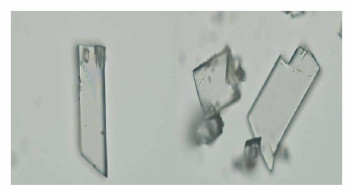-
摘要: 在连续谱激光(532 nm)照射下,观察到联苯衍生物有光折变现象。本文制备了(4-羟基苯基)-5-嘧啶醇、4'-羟基-4-联苯基腈、3-氨基-4-苯基苯酚和4,4'-Biphenol两类实验样品,将联苯衍生物分别溶于N,N-二甲基甲酰胺(DMF)溶剂中,获得溶液浓度比为2wt%的4个溶液样品;将联苯衍生物溶于无水乙醇通过常温慢速挥发,制成了4个单晶体样品。在激光照射下,2-(4-羟基苯基)-5-嘧啶醇、4'-羟基-4-联苯基腈和3-氨基-4-苯基苯酚3个溶液样品中观察到周期性对称的明暗相间的空间条纹。无论如何增大激光功率密度,在4,4'-Biphenol溶液中,都没有观察到类似的空间条纹。在强光功率密度照射下,2-(4-羟基苯基)-5-嘧啶醇、4'-羟基-4-联苯基腈、3-氨基-4-苯基苯酚3个单晶体出现光斑畸变,同样在4,4'-双酚单晶中没有观察到光斑畸变。在激光照射下或无光照射时,测量到具有非对称基团的联苯衍生物样品的光电流与暗电流相差大约为10 nA。光斑畸变的伸长方向与激光的偏振态有关。在溶液和单晶样品中,光斑畸变的光功率密度的阈值分别是100 W/cm2和10 W/cm2。上述实验结果可认为对称的周期性明暗空间条纹是由光折变效应引起的,激光通过样品时,由于联苯衍生物的极性分子受光电场的作用,在光照区与非光照区产生空间电荷场,由该空间电荷场引起样品折射率变化,从而形成明暗相间的空间条纹。本文首次发现联苯衍生物是一种光折变材料。Abstract: The photorefractive phenomenon was observed in biphenyl derivatives materials under continuous wave laser(532nm) irradiation. Two types of sample were prepared:biphenyl derivatives(2-(4-hydroxypheny)-5-pyrimidinol, 4'-hydroxy-4-biphenyl carbonitrile, 3-amino-4-phenylphenol and 4, 4'-Biphenol) were respectively dissolved in N, N-dimethylformamide(DMF) detaining 4-solution samples, and the concentration was 2wt%; biphenyl derivatives were dissolved into a saturated solution of anhydrous ethanol as a solute, and the single crystals of biphenyl derivatives were obtained by slow evaporation of the ethanol solution at an ambient temperature. The experimental results show that cyclic symmetric bright-dark spatial stripes were formed after the laser beam transmitted through the 2-(4-hydroxypheny)-5-pyrimidinol, 4'-hydroxy-4-biphenyl carbonitrile and 3-amino-4-phenylphenol solutions with an asymmetric chromophore. On the other hand, the transmitted laser spot has no change in 4, 4'-Biphenol solution, no matter how the laser power density was increased. A distorted beam was observed when the 2-(4-hydroxypheny)-5-pyrimidinol, 4'-hydroxy-4-biphenyl carbonitrile, and 3-amino-4-phenylphenol single crystals were irradiated by high optical power density, while the laser beam spot experienced no change in the 4, 4'-Biphenol single crystal. The different values of the Open/Dark current were about 10 nA in biphenyl derivatives with an asymmetric chromophore. The distorted optical spot stretched along the laser polarization. The threshold value of laser power density for distorted spot was about 100 W/cm2 and 10 W/cm2 in the solutions and single crystals of biphenyl derivatives with an asymmetric chromophore. An explanation was proposed for the symmetric cyclic bright-dark spatial stripes, being that they were induced by the photorefractive effect. The photorefractive effect relies on the formation of a space-charge field through the illumination of inhomogeneous light intensity patterns. The biphenyl derivatives were found to be photorefractive materials.
-
Key words:
- photorefractive effect /
- spatial stripes /
- space charge field /
- biphenyl derivatives
-
Table 1. Molecular structures of the experimental samples
Sample Molecular Structure A:4, 4′-Biphenol 
B:4′-hydroxy-4-biphenylcarbonitrile 
C:2-(4-hydroxypheny)-5-pyrimidinol 
D:3-amino-4-phenylphenol 
Solvent:N, N-Dimethylformamide(DMF) 
Table 2. Photorefractive effect in biphyenyl derivatives threshold of laser power density
Sample Solution Single crystal A:4, 4′-Biphenol No PR effect No PR effect B:4′-hydroxy-4-biphenylcarbonitrile 230 W/cm2 40 W/cm2 C:2-(4-hydroxypheny)-5-pyrimidinol 150 W/cm2 20 W/cm2 D:2-amino-4-phenylphenol 100 W/cm2 10 W/cm2 Solvent:N, N-dimethylformamide(DMF) No PR effect No PReffect -
[1] 戴军, 陈景东, 何影记, 等.铜掺杂氧化锌纳米棒的非线性光学响应竞争特性[J].发光学报, 2017, 38(7):855-861. http://d.old.wanfangdata.com.cn/Periodical/fgxb201707003DAI J, CHEN J D, HE Y J, et al.. Competition in nonlinear optical properties of Cu-doped ZnO nanorods[J]. Chinese Journal of Luminescence, 2017, 38(7):855-861.(in Chinese) http://d.old.wanfangdata.com.cn/Periodical/fgxb201707003 [2] CICOIRA F, SANTATO C. Organic Electronics:Emerging Concepts and Technologies[M]. Weinheim:Wiley-VCH, 2013. [3] OSTROVERKHOVA O. Handbook of Organic Materials for Optical and (opto) Electronic Devices: Properties and Applications[M]. Cambridge:Woodhead Publishing, 2013:367-370. [4] SUN S S, DALTON L R. Introduction to Organic Electronic and Optoelectronic Materials and Devices[M]. 2nd ed. Boca Raton:CRC Press, 2016. [5] KÖHLER A, BÄSSLER H. Electronic Processes in Organic Semiconductors:An Introduction[M]. Weinheim:Wiley-VCH Verlag GmbH & Co. KGaA, 2015. [6] 龚梓博, 陆星, 施可彬, 等.光学频率梳非线性传输及其在相位噪声探测中的应用[J].中国光学, 2015, 8(1):39-44. http://www.chineseoptics.net.cn/CN/abstract/abstract9259.shtmlGONG Z B, LU X, SHI K B, et al.. Nonlinear propagation of optical frequency comb and its application in phase noise detection[J]. Chinese Optics, 2015, 8(1):39-44.(in Chinese) http://www.chineseoptics.net.cn/CN/abstract/abstract9259.shtml [7] SUTTER K, HULLIGER J, GVNTER P. Photorefractive effects observed in the organic crystal 2-cyclooctylamino-5-nitropyridine doped with 7, 7, 8, 8-tetracyanoquinodimethane[J]. Solid State Communications, 1990, 74(8):867-870. doi: 10.1016/0038-1098(90)90952-8 [8] SUTTER K, GVNTER P. Photorefractive gratings in the organic crystal 2-cyclooctylamino-5-nitropyridine doped with 7, 7, 8, 8-tetracyanoquinodimethane[J]. Journal of the Optical Society of America B, 1990, 7(12):2274-2278. doi: 10.1364/JOSAB.7.002274 [9] DUCHARME S, SCOTT J C, TWIEG R J, et al.. Observation of the photorefractive effect in a polymer[J]. Physical Review Letters, 1991, 66(14):1846-1849. doi: 10.1103/PhysRevLett.66.1846 [10] MARINOVA V, LIU R C, LIN S G, et al.. Near-infrared sensitive organic-inorganic photorefractive device[J]. Optical Review, 2016, 23(5):811-816. doi: 10.1007/s10043-016-0244-4 [11] LIU W, YANG H T, WU W B, et al.. Calix[4]resorcinarene-based branched macromolecules for all-optical photorefractive applications[J]. Journal of Materials Chemistry C, 2016, 4(45):10684-10690. doi: 10.1039/C6TC04062D [12] XU SH A, FANG CH, WU Y ZH, et al.. Photorefractive hyper-structured molecular glasses constructed by calix[4]resorcinarene core and carbazole-based methine nonlinear optical chromophore[J]. Dyes and Pigments, 2017, 142:8-16. doi: 10.1016/j.dyepig.2017.03.001 [13] TSUJIMURA S, FUJIHARA T, SASSA T, et al.. Characterization of carrier transport and trapping in photorefractive polymer composites using photoemission yield spectroscopy in air[J]. Macromolecular Chemistry and Physics, 2016, 217(16):1785-1791. doi: 10.1002/macp.v217.16 [14] OSTROVERKHOVA O. Organic optoelectronic materials: mechanisms and applications[J]. Chemical Reviews, 2016, 116(22):13279-13412. doi: 10.1021/acs.chemrev.6b00127 [15] 秦沛, 任玉, 刘丽炜, 等.金属纳米颗粒等离激元共振增强非线性介质谐波的发展现状[J].中国光学, 2016, 9(2):213-225. http://www.chineseoptics.net.cn/CN/abstract/abstract9415.shtmlQIN P, REN Y, LIU L W, et al.. Development of plasmon-resonance of metal nanoparticles enhanced harmonic generation in nonlinear medium[J]. Chinese Optics, 2016, 9(2):213-225.(in Chinese) http://www.chineseoptics.net.cn/CN/abstract/abstract9415.shtml [16] POPE M, SWENBERG C E. Electronic Processes in Organic Crystals and Polymers[M]. 2nd ed. New York:Oxford University Press, 1999. [17] MOON J S, KIM K, HAN D W, et al.. Recent progress in organic photorefractive materials[J]. Applied Spectroscopy Reviews, 2018, 53(2-4):203-223. doi: 10.1080/05704928.2017.1323307 [18] LEO K. Elementary Processes in Organic Photovoltaics[M]. Cham:Science, 2017:272. -






 下载:
下载:








